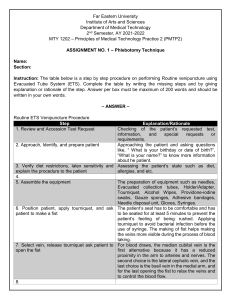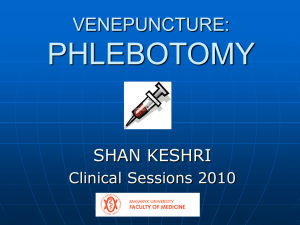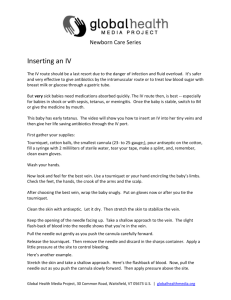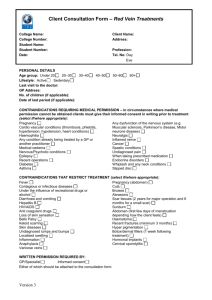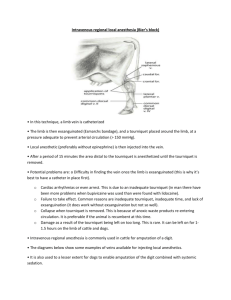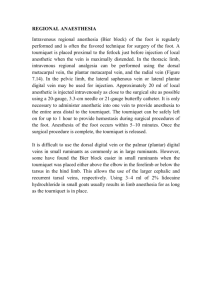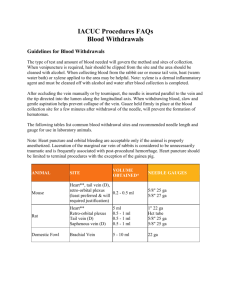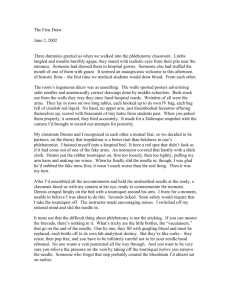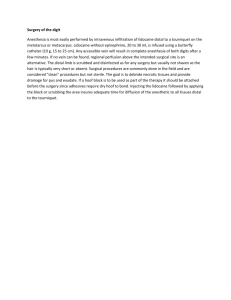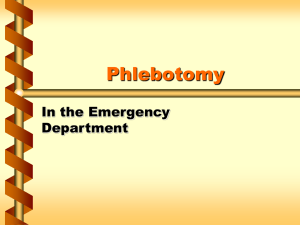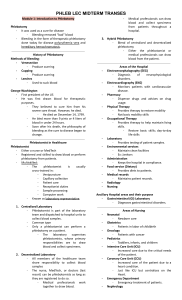Phlebotomy - Effingham County Schools
advertisement
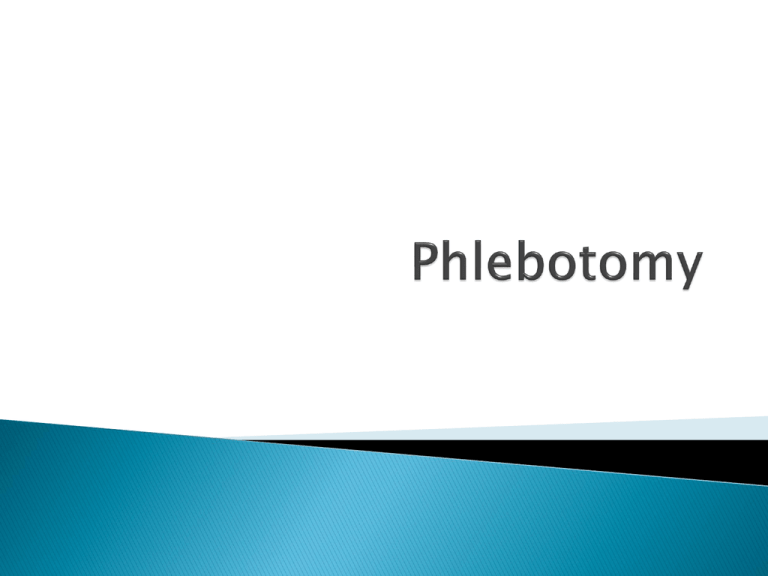
Phlebotomy means collecting blood Venipuncture is the act of puncturing a vein with a needle Thrombophlebitis is the inflammation of a vein with blood clot formation Thrombus a blood clot Hemolysis is the breaking of blood cells Coagulate “the act of blood clotting” Hematoma a blood-filled bruise caused when a blood vessel is broken; collection of blood under the skin Lumen is the hollow center of a structure (needle) Bevel is the slant at the end of a needle Vacutainer is a vacuum tube used to draw blood Butterfly smaller needle with wings on each side used to draw blood; winged infusion needle Straight needle is a straight needle used to draw blood Anticubital space is the area in front of the elbow Ecchymosis a bruise Thrombus a blood clot formed in a blood vessel Coagulate is the medical term describing blood clotting Centrifuge is a device used in the lab to spin blood and separate the liquid and solid portions of the blood Always ask pt if he/she is allergic to latex before drawing blood! Why? Many medical supplies still contain latex and could cause an allergic reaction Size/diameter of lumen: smaller the gauge= larger the lumen. Choice depends on amount of blood being drawn Length: user preference, may need longer needle for obese patients Use a 21 gauge or bigger to prevent hemolysis Which needle is larger in diameter? 16 gauge or 20 gauge Places to avoid: -arm w/ IV solution infusing -infected/swollen are -area w/ rash -arm w/ a dialysis graft or same side as a mastectomy -site w/ injury, burn, scarring -lower extremities -inner portion of wrist- why? Use a tourniquet to evaluate which vein to use Apply tourniquet 2-3 inches above elbow. How? See pt 132; practice Not too tight; tight enough to cause the veins to stand out but not so tight to occlude arterial flow- check pulse Evaluate vein selection Remove tourniquet until ready to perform full procedure ( within 1-2 minutes) Antecubital space are most commonly used Apply tourniquet 2-3 inches above elbow or desired blood draw site A good vein stands our when the tourniquet is applied Use “touch” more than “sight” Use vein that feels “springy” Alcohol Betadine Chlorhexidine Tourniquet Needle(smaller number=bigger needle) Vacutainer Adapter Gauze bandaid 1. 2. 3. 4. 5. 6. 7. 8. 9. Gather supplies Explain procedure/screen for latex allergy Standard precautions Examine arm Place tourniquet; find vein (1-2 min max) Release tourniquet ready supplies and clean site Replace tourniquet without contaminating Stabilize the vein 10. Enter vein at 15 degree angle 11. When you see “flash”, push vacutainer into adapter 12. Allow tube to fill( if multiple tubes drawn; follow correct order) 13. Release tourniquet as last tube is filling 14. Place gauze over site as needle is removed 15. Hold pressure x 2-3 minutes 16. Place bandaid if bleeding has stopped Invert blood tubes 5-10 times. See 137 Label tubes according to facility requirements Send to lab in biohazard bag x 2 Used when a doctor suspects septicemia: the presence of pathogenic organism in the blood stream Blood is drawn into an aerobic/anaerobic bottle and sent to lab to “grow” MUST be very careful not to contaminate draw site with bacteria while drawing blood cultures…….. Why? Microdraw: is a small skin puncture (capillary puncture) used for collecting blood specimens. This technique for obtaining a blood sample provides a very small sample. The blood is a mixture of venous, capillary, and arterial blood A lancet is a tiny, sharp, sterile device used to puncture the skin to collect small blood samples Discuss types of lancets……….. Smaller lancets for babies Larger lancets for adults Use recommendations of the facility you work When the blood is collected from a capillary puncture, it is tested on a reagent strip or microvette collection device(must be ¾ full) Sides of the middle and ring fingertips Do not use the tip/pad of fingertip May use earlobe (not preferred) Puncture perpendicular to fingertip Warm area if needed Always alternate sites Adult(1yr and up) Medial or lateral heel(preferred) Great toe Puncture at 45 degree angle Always alternate sites warm area if needed Infant(birth to 1yr) 1. 2. 3. 4. 5. 6. Gather supplies: lancet , gloves, alcohol, gauze, bandaid, microvette collection device, biohazard bag, sharps box…… Check order, identify correct patient Introduce yourself and explain procedure Wash hands/ Standard Precautions Choose site Clean site w/ alcohol in circle w/ 2 inch diameter 7. Allow alcohol to dry 8. Hold plastic end of lancet with dominant hand and remove plastic cover 9. Pierce the skin at the appropriate angle by holding the finger/foot with your nondominant hand. 10. Discard lancet in sharps box 11. Wipe first drop of blood w/ gauze 12. Allow next drops of blood to fill microvette or place on reagent strip 13. May apply gentle squeeze to area but not too hard- allow tube to fill ¾ full 14. Hold pressure over site until the bleeding stops and apply band aid 15. Label sample and place in biohazard bag according to facility’s standards
